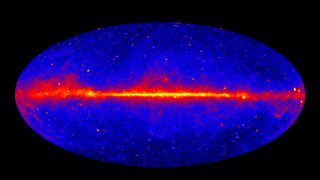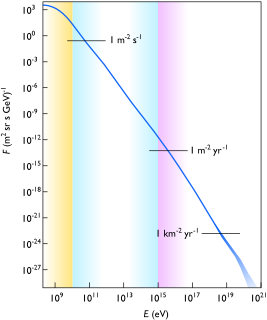
Cosmic rays are high-energy protons and atomic nuclei which move through space at nearly the speed of light. They originate from the sun, from outside of the solar system, or even from distant galaxies. Upon impact with the Earth's atmosphere, cosmic rays can produce showers of secondary particles that sometimes reach the surface. Data from the Fermi Space Telescope (2013) have been interpreted as evidence that a significant fraction of primary cosmic rays originate from the supernova explosions of stars. Active galactic nuclei also appear to produce cosmic rays, based on observations of neutrinos and gamma rays from blazar TXS 0506+056 in 2018.

Astronomy is a natural science that studies celestial objects and phenomena. It uses mathematics, physics, and chemistry in order to explain their origin and evolution. Objects of interest include planets, moons, stars, nebulae, galaxies, and comets. Relevant phenomena include supernova explosions, gamma ray bursts, quasars, blazars, pulsars, and cosmic microwave background radiation. More generally, astronomy studies everything that originates outside Earth's atmosphere. Cosmology is a branch of astronomy. It studies the Universe as a whole.

Neutrino astronomy is the branch of astronomy that observes astronomical objects with neutrino detectors in special observatories. Neutrinos are created as a result of certain types of radioactive decay, or nuclear reactions such as those that take place in the Sun, in nuclear reactors, or when cosmic rays hit atoms. Due to their weak interactions with matter, neutrinos offer a unique opportunity to observe processes that are inaccessible to optical telescopes.
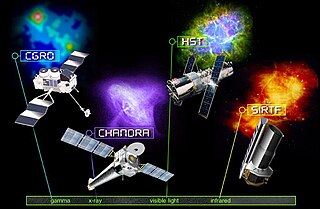
NASA's series of Great Observatories satellites are four large, powerful space-based astronomical telescopes launched between 1990 and 2003. They were built with different technology to examine specific wavelength/energy regions of the electromagnetic spectrum: gamma rays, X-rays, visible and ultraviolet light, and infrared light. Three remain operational as of 2019.
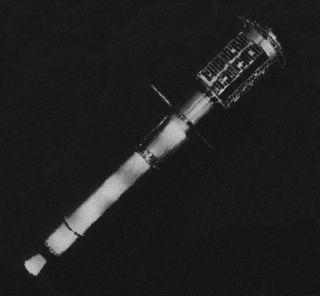
Explorer 11 was an American Earth-orbital satellite that carried the first space-borne gamma-ray telescope. This was the earliest beginning of space gamma-ray astronomy. Launched on April 27, 1961 by a Juno II rocket, the satellite returned data until November 17, when power supply problems ended the science mission. During the spacecraft's seven-month lifespan it detected twenty-two events from gamma-rays and approximately 22,000 events from cosmic radiation.

Solar Energy Generating Systems (SEGS) in California, with the combined capacity from three separate locations at 354 megawatts, is now the world's second largest solar thermal energy generating facility, after the commissioning of the even larger Ivanpah facility in 2014. It consists of nine solar power plants in California's Mojave Desert, where insolation is among the best available in the United States. SEGS I–II (44 MW) are located at Daggett, SEGS III–VII (150 MW) are installed at Kramer Junction, and SEGS VIII–IX (160 MW) are placed at Harper Lake. NextEra Energy Resources operates and partially owns the plants located at Kramer Junction. On January 26, 2018, the SEGS VIII and IX at Harper Lake were sold to renewable energy company Terra-Gen, LLC. A tenth plant had been in construction and SEGS XI and SEGS XII had been planned by Luz Industries, but the developer filed for bankruptcy in 1992, because it was unable to secure construction financing.

The Harvard–Smithsonian Center for Astrophysics (CfA) is a research institute which carries out a broad program of research in astronomy, astrophysics, earth and space sciences, and science education. The center's mission is to advance knowledge and understanding of the universe through research and education in astronomy and astrophysics.

The Haleakalā Observatory, also known as the Haleakalā High Altitude Observatory Site, is Hawaii's first astronomical research observatory. It is located on the island of Maui and is owned by the Institute for Astronomy of the University of Hawai'i, which operates some of the facilities on the site and leases portions to other organizations. Tenants include the Air Force Research Laboratory (AFRL) and the Las Cumbres Observatory Global Telescope Network (LCOGTN). At over 3,050 meters (10,010 ft) in altitude, the summit of Haleakalā is above one third of the Earths's troposphere and has excellent astronomical seeing conditions.

The Pierre Auger Observatory is an international cosmic ray observatory in Argentina designed to detect ultra-high-energy cosmic rays: sub-atomic particles traveling nearly at the speed of light and each with energies beyond 1018 eV. In Earth's atmosphere such particles interact with air nuclei and produce various other particles. These effect particles (called an "air shower") can be detected and measured. But since these high energy particles have an estimated arrival rate of just 1 per km2 per century, the Auger Observatory has created a detection area of 3,000 km2 (1,200 sq mi)—the size of Rhode Island, or Luxembourg—in order to record a large number of these events. It is located in the western Mendoza Province, Argentina, near the Andes.

The Fred Lawrence Whipple Observatory is an American astronomical observatory owned and operated by the Smithsonian Astrophysical Observatory (SAO); it is their largest field installation outside of their main site in Cambridge, Massachusetts. It is located near Amado, Arizona on the summit, a ridge and at the foot of Mount Hopkins.

The Amargosa Desert is located in Nye County in western Nevada, United States, along the California–Nevada border, comprising the northeastern portion of the geographic Amargosa Valley, north of the Ash Meadows National Wildlife Refuge

A neutrino detector is a physics apparatus which is designed to study neutrinos. Because neutrinos only weakly interact with other particles of matter, neutrino detectors must be very large to detect a significant number of neutrinos. Neutrino detectors are often built underground, to isolate the detector from cosmic rays and other background radiation. The field of neutrino astronomy is still very much in its infancy – the only confirmed extraterrestrial sources so far as of 2018 are the Sun and the supernova 1987A in the nearby Large Magellenic Cloud. Another likely source is the blazar TXS 0506+056 about 3.7 billion light years away. Neutrino observatories will "give astronomers fresh eyes with which to study the universe."
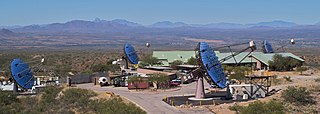
VERITAS is a major ground-based gamma-ray observatory with an array of four 12 meter optical reflectors for gamma-ray astronomy in the GeV – TeV photon energy range. VERITAS uses the Imaging Atmospheric Cherenkov Telescope technique to observe gamma-rays that cause particle showers in Earth's upper atmosphere. The telescope design is based on the design of the existing 10m gamma-ray telescope at the Fred Lawrence Whipple Observatory. It consists of an array of imaging telescopes deployed such that they permit the maximum versatility and give the highest sensitivity in the 50 GeV – 50 TeV band. This very high energy observatory, completed in 2007, effectively complements the Fermi Gamma-ray Space Telescope due to its large collection area as well as its higher energy bound.
The Solar Tower Atmospheric Cherenkov Effect Experiment (STACEE), is a gamma ray detector located near Albuquerque, New Mexico. Observations with STACEE began in October 2001 and concluded in June 2007. Gamma rays were observed from objects such as the Crab Nebula, a supernova remnant, and Markarian 421, a blazar. STACEE uses the heliostats and space on the receiver tower of the National Solar Thermal Test Facility (NSTTF) operated by the Sandia National Laboratories on the grounds of the Kirtland Air Force Base. In the daytime, the facility is used for solar energy research. During the night STACEE uses the heliostats to reflect the brief flashes of Čerenkov radiation caused by gamma rays hitting the upper atmosphere to photodetectors mounted in the tower. STACEE is a nonimaging telescope, meaning that it detects the light from a portion of the sky, but does not resolve the light into an image.
Milagro was a ground-based water Cherenkov radiation telescope situated in the Jemez Mountains near Los Alamos, New Mexico at the Fenton Hill Observatory site. It was primarily designed to detect gamma rays but also detected large numbers of cosmic rays. It operated in the TeV region of the spectrum at an altitude of 2530 m. Like conventional telescopes, Milagro was sensitive to light but the similarities ended there. Whereas "normal" astronomical telescopes view the universe in visible light, Milagro saw the universe at very high energies. The light that Milagro saw was about 1 trillion times more energetic than visible light. While these particles of light, known as photons, are the same as the photons that make up visible light, they behave quite differently due to their high energies.
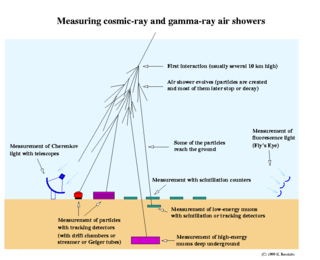
A cosmic-ray observatory is a scientific installation built to detect high-energy-particles coming from space called cosmic rays. This typically includes photons, electrons, protons, and some heavier nuclei, as well as antimatter particles. About 90% of cosmic rays are protons, 9% are alpha particles, and the remaining ~1% are other particles.
The Tunka experiment now named TAIGA measures air showers, which are initiated by charged cosmic rays or high energy gamma rays. TAIGA is situated in Siberia in the Tunka valley close to lake Baikal. Meanwhile, TAIGA consists of five different detector systems: Tunka-133, Tunka-Rex, and Tunka-Grande for charged cosmic rays; Tunka-HiSCORE and Tunka-IACT for gamma astronomy. From the measurements of each detector it is possible to reconstruct the arrival direction, energy and type of the cosmic rays, where the accuracy is enhanced by the combination of different detector systems.




